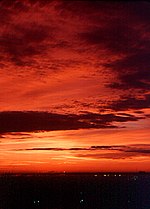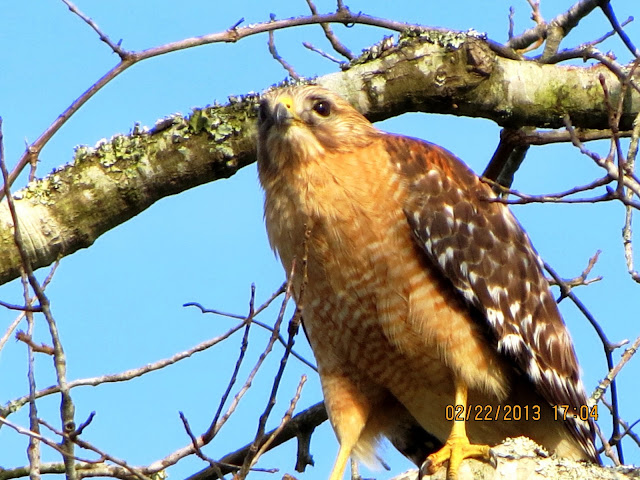Hi Everybody!!
I thought it appropriate to leave February with a Red Sunset. March 1 is Opening Day for the season at Kates Cabin Bird Sanctuary in Texas!
Featuring: The "Spring Migration" of Birds and The "Spring Bloom"of my Woodland Garden, designed very carefully by me to have a certain look at full bloom. (Ha! not this year!) The azaleas are in full bloom and the white trees and shrubs are not even close to opening! Weather is off-way off. The sky is Red-too red. I will let You ponder "Why?" as you view my photoshoot of tonight's CHEMICAL SKY.
http://en.wikipedia.org/wiki/Weather_lore
Weather lore
From Wikipedia, the free encyclopedia
Weather lore is the body of informal folklore related to the prediction of the weather.
It has been a human desire for millennia to make accurate weather predictions. Oral and written history is full ofrhymes, anecdotes, and adages meant to guide the uncertain in determining whether the next day will bring fair or foul weather. For the farmer wanting to plant crops, for the merchant about to send ships on trade, foreknowledge of tomorrow's circumstances might mean the difference between success and failure. Prior to the invention of the mercury barometer, it was very difficult to gather numerical data of any predictive value. Even though there were devices such as the weather stick which gave some indication of moisture changes, the only instrument of any reliability was human experience.
Where weather happens
It is in Earth's middle latitudes, between roughly 30° to 60° North and South, that a significant portion of humanity's daily activities take place. It is also within these rough boundaries that "weather" can be said to happen, that is, where meteorological phenomena do not persist over the long term, and where it may be warm, sunny, and calm one day, and cold and stormy the next.
A great percentage of the world's population lives in the equatorial regions,[4] but for the most part, these regions do not experience weather as it is understood by this definition. The Sahara Desert, for instance, is almost uniformly hot and dry, whereas weather trends on the Indian subcontinent and in the western Pacific, for instance, the monsoonal belt, occur gradually over the very long term, and the diurnal weather patterns remain constant.
Weather folklore, therefore, refers to this mid-latitude region of daily variability. While most of it applies equally to the Southern Hemisphere, the Southern Hemisphere resident may need to take into account the fact that weather systems rotate opposite to those in the North. For instance, the "crossed winds"[5] rule (see below) must be reversed for the Australian reader.
True lore, and why
Red sky at night
In North America:
-
- Red sky at night, sailor's delight,
- Red sky at morning, sailors take warning.
In Great Britain and Ireland:
-
- Red sky at night, shepherd's delight,
- Red sky in morning, shepherd's warning.
As well as other variations, such as this one from Denmark/Norway, which translates to "Morning red gives wet days, Evening red gives sweet days":
-
- Morgenrøde gir dage bløde.
- Kveldsrøde gir dage søde.
Italian variation, which translates to "Red at night, good weather is hoped, red in the morning bad weather approaches" goes as:
-
- Rosso di sera, bel tempo si spera,
- rosso di mattina mal tempo si avvicina.
A Dutch variation is:
-
- Avondrood, morgen mooi weer aan boord,
- Ochtendrood, vanavond water in de sloot.
A French variation, which translates to "Red at night, great hope, Red in the morning, rain on the way," goes:
-
- Rouge le soir, bel espoir,
- Rouge le matin, de la pluie en chemin.
Weather systems typically move from west to east, and red clouds result when the sun shines on their undersides at either sunrise orsunset.[6][7] At these two times of day, the sun's light is passing at a very low angle through a great thickness of atmosphere commonly known as The Belt of Venus. The result of which is the scattering out of most of the shorter wavelengths — the greens, blues, and violets — of thevisible spectrum, and so sunlight is heavy at the red end of the spectrum. If the morning skies are red, it is because clear skies to the east permit the sun to light the undersides of moisture-bearing clouds coming in from the west. Conversely, in order to see red clouds in the evening, sunlight must have a clear path from the west in order to illuminate moisture-bearing clouds moving off to the east. There are many variations on this piece of lore, but they all carry the same message.
- Matthew 16:2b–3 -- [Jesus] replied, [to some Pharisees and Sadducees that wanted to "test" him by asking him to show them a sign from heaven]
- "When evening comes, you say,
- 'It will be fair weather: for the sky is red.'
- And in the morning,
- 'Today it will be stormy, for the sky is red and overcast.'
- You know how to interpret the appearance of the sky,
but you cannot interpret the signs of the times."
...this is brendasue signing off from Rainbow Creek. February is over, see You in March!!!! Love and Peace to All
Of course, More!
http://www.youtube.com/watch?v=nLLEBAQLZ3Q
http://www.youtube.com/watch?v=YrLk4vdY28Q
O+O













































































